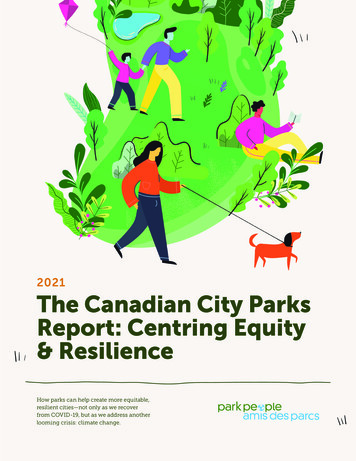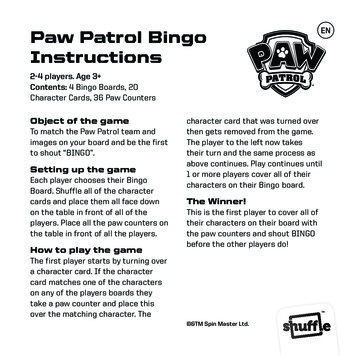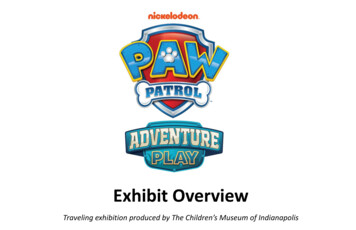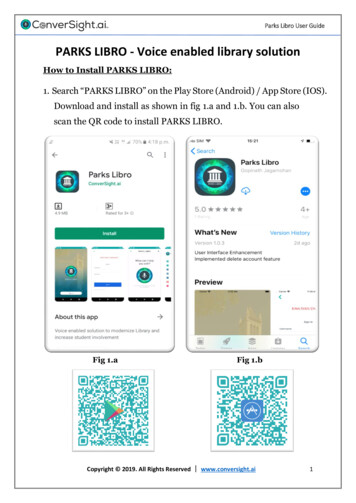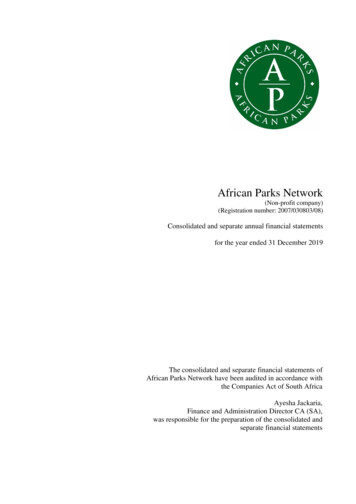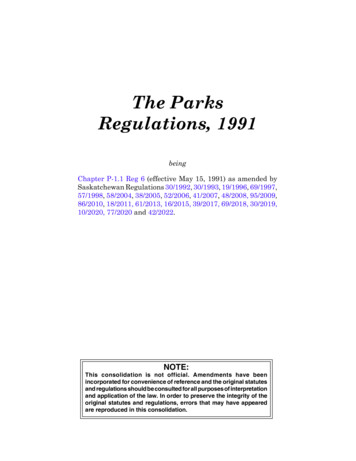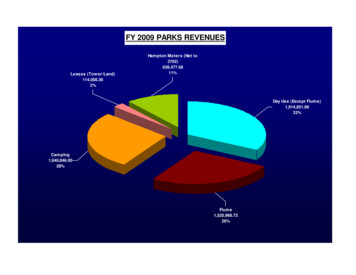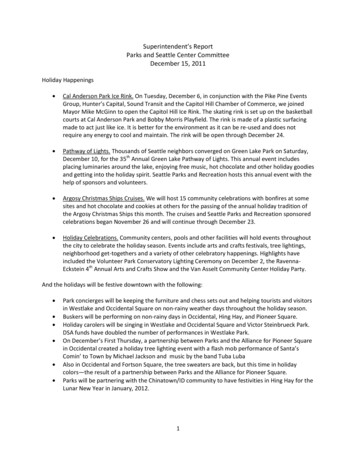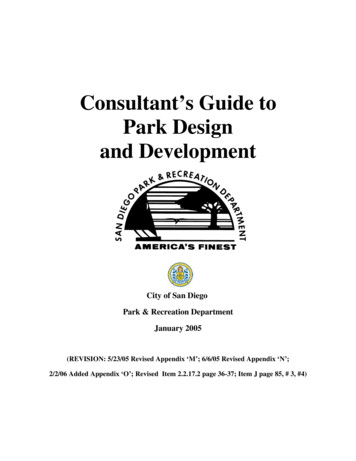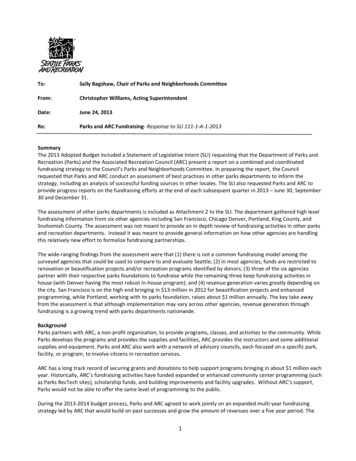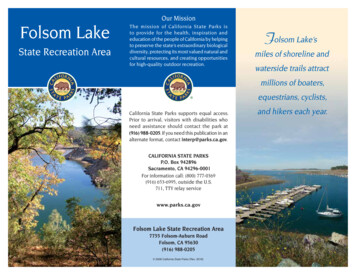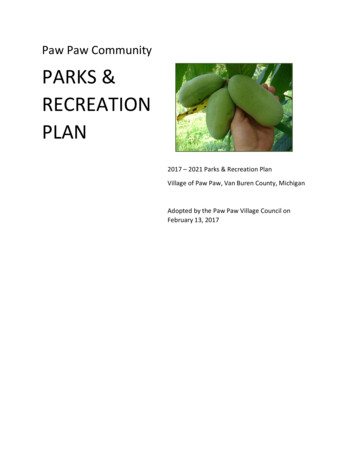
Transcription
Paw Paw CommunityPARKS &RECREATIONPLAN2017 – 2021 Parks & Recreation PlanVillage of Paw Paw, Van Buren County, MichiganAdopted by the Paw Paw Village Council onFebruary 13, 2017
ACKNOWLEDGMENTSThank you!The participation and cooperation of community leaders, residents and membersof local service organizations in the preparation of the 2017 – 2021 CommunityParks & Recreation Plan was greatly appreciated and we thank everyone whoparticipated in its development. The content of this Plan reflects the ongoingcollaboration between residents, stakeholders, and the Village Council.In particular, we acknowledge the efforts of:VILLAGE COUNCILRoman Plaszczak, PresidentDouglas CraddockMarcos FloresNadine JarvisEric LarcineseMary Houppert-McIntoshDonne RohrPARKS AND RECREACTION BOARD (Advisory)Roman PlaszczakJohn SmallNadine JarvisTed MajorRichard SchallhornLarry NielsenADMINISTRATIONLarry Nielsen, Village ManagerSarah Moyer-Cale, Assistant Village ManagerJohn Small, Director of Department of Public Services
TABLE OF CONTENTSCHAPTER 1Introduction1Background1Planning Process1Detailed Description of Plan3CHAPTER 2Community Description5Natural Features Framework6Recreational Framework7CHAPTER 3Inventory Overview9Classification System9Accessibility10Village Parks & Recreational Inventory12Regional Inventory20Recreation Systems Analysis25CHAPTER 4Administrative Organization30Volunteers & Collaboration30Parks & Recreation Funding32Parks & Recreation Grant History32CHAPTER 5Goals & Objectives34
CHAPTER 6Action Plan40Project Descriptions43APPENDIXo Affidavit of Publication for 30-Day Comment Period and Village Council PublicHearingo Copy of Review Comments Receivedo Minutes from February 13, 2017 Village Council Meetingo Resolution of Plan Adoption by Village Councilo Transmittal Letter to Van Buren County, Southwest Michigan PlanningCommissiono MDNR Plan Certification Checklist
2017 – 2021 Community Parks & Recreation Plan1 - INTRODUCTIONBACKGROUNDWelcome to the 2017 - 2021 Community Parks and Recreation Plan by the Villageof Paw Paw. This Plan reflects a vision for the future of Paw Paw’s parks andrecreation facilities, operations, and maintenance for the next five years. Inaddition, the Plan is intended to form the basis for future application forrecreation grant funding from the Michigan Department of Natural Resources(MDNR) and other granting agencies and foundations. The Plan was prepared inaccordance with the MDNR’s Guidelines for the Development of Community Park,Recreation, Open Space and Greenway Plans.PLANNING PROCESSThe Parks and Recreation Board of the Village of Paw Paw and the Paw PawVillage Council are responsible for guiding existing and future conditions of parksand recreation facilities and programs for community residents and visitors. The1991 – 2010 Community Parks and Recreation Plan was updated in 2009 by theParks and Recreation Board with assistance from Western Michigan Universitystudents. Since 2009, various needs to improve and expand the community’sparks and recreation opportunities have been identified.1 Page
2017 – 2021 Community Parks & Recreation PlanThe 2017-2021 Community Parks and Recreation Plan was prepared with thetechnical assistance of the Village Planning Consultant, Western MichiganUniversity students, and with the active involvement of the Parks and RecreationBoard. Citizen input received through guided reviews of key Plan componentsover several months and Village public hearings also contributed to this Plan.Following initial review by the Parks and Recreation Board, the Plan wassubmitted to the Village Council. Throughout the process, all meetings were opento the public and advertised pursuant to the Open Meetings Act. Notice of thepublic hearings was posted and published as required by the MDNR.Major steps in the development of the CommunityParks and Recreation Plan were as follows: Kick-off Meeting between the Parks and RecreationBoard, Village Manager and Village Planning Consultantto discuss existing parks and recreation facilities, futurerecreation needs, and major objectives for the updatedParks and Recreation Plan. Site Visits to inventory existing facilities and determine changes since the 2009update to the Parks and Recreation Plan. Public Participation via a community wide review and comment period on theexisting facilities inventory, recreational goals and objectives and action plan. Meeting with Village Staff and planning consultant on the formulation of thegoals and objectives, and review of the action plan. Initial Draft of the Plan issued on January 12, 2017, followed by a publishednotice of the 30-day review and comment period. Public Comments received during the 30-day review and comment period. Meeting of the Village Council, held on February 13, 2017 to hold a publichearing on the 2017-2021 Parks and Recreation Plan and to adopt the Plan.2 Page
2017 – 2021 Community Parks & Recreation PlanDETAILED DESCRIPTION OF THE PLANTASK ONE: COMMUNITY DESCRIPTIONThe first task was to obtain a general description of Paw Paw’s physical andsocial features, specifically those instrumental in shaping the framework forrecreational activity in the community. Current information was availablefrom the recently updated Master Plans for the Village of Paw Paw. Thecommunity description is found in Chapter 2.TASK TWO: PARKS & RECREATION INVENTORY & PARK SYSTEM ANALYSISThe parks and recreation inventory includes descriptions of facilities withinthe Village, including both Village-owned properties and recreationalfacilities operated by other entities, such as the Paw Paw School District.The information provided includes the acreage, barrier-free accessibilityrating, primary service area, available recreation amenities, anddescriptions of the physical attributes of the facilities and is found inChapter 3. Based on the data collected through the inventory process, eachfacility was then classified in accordance with national and state guidelines.To provide a broader picture of the recreational resources in thecommunity and of the region, the inventory was expanded to includepublic/private recreational amenities located within 10 miles of the Villageboundaries, which encompassed the entirety of Paw Paw and AntwerpTownships. This additional information can also be found in Chapter 3.TASK THREE: ADMINISTRATIVE STRUCTURE & FUNDINGChapter 4 includes the community’s administrative and organizationalstructure for its parks and recreation facilities, a review of the parks andrecreation expenditures and revenue sources, and the grant history offunding received from the MDNR.TASK FOUR: GOALS & OBJECTIVESChapter 5 details the results of the public engagement effort and theresulting recreational goals and objectives of the Village. Further, the goalsand objectives were reviewed for alignment with the recreational plans ofadjacent communities and the Region 8 Prosperity Plan.3 Page
2017 – 2021 Community Parks & Recreation PlanTASK FIVE: ACTION PLANTaking into account the analysis, goals and objectives and public inputresults, a five-year action plan was created. The action plan provides theVillage a checklist of what projects are to be accomplished, when andwhere they will occur, who will accomplish them, how much they will cost,and potential funding sources. The action plan is set forth in Chapter 6.4 Page
2017 – 2021 Community Parks & Recreation Plan2 - COMMUNITYDESCRIPTIONPaw Paw is a desirable place to live, withhistoric village charm, unique andbeautiful natural assets, and a claim asone of the premier wine growing andprocessing areas in the Midwest.The Downtown District is the heart of thecommunity. Located centrally at theintersection of Kalamazoo Street and RedArrow Hwy/Michigan Avenue, downtownPaw Paw is a walkable, pedestrianfriendly corridor with neighborhood-servicing retail businesses and restaurants.Paw Paw was settled in 1828 and named for the pawpaw trees that still growalong the Paw Paw River. Today, pawpaw trees are less common in the area, dueto the clearing of forests. Trees can be found in the Village. The Village of PawPaw has a beautiful setting and bountiful natural resources, primarily water andsoils. Just as with much of southwest Michigan, the area has an ideal climate forfruit production. This was recognized by early settlers to Van Buren County andthe Village.Paw Paw Village celebrates a richhistorical and cultural heritage with itsneighboring Townships of Paw Paw andAntwerp. The community’s history ofwineries and distilleries has provided thearea with the renowned annual Wine &Harvest Festival.The Village of Paw Paw is fortunate to be located at the confluence of the Eastand West (also referred to as the South branch) branches of the Paw Paw Riverthat feed the 172-acre Maple Lake. Built by the Village in 1907, the reservoir wasbuilt to provide power and flood control; however, the dam no longer generateselectricity. The lake provides many recreational opportunities, including fishing,5 Page
2017 – 2021 Community Parks & Recreation Planboating and kayaking, and the marshy lowlands surrounding the river and lakeoffer a natural habitat for a wide variety of woodland and wetland species.The presence of the lakes in both Paw Paw Township and the Village of Paw Pawand the numerous related parks and recreational sites located in the center of thecommunity have encouraged continued support of the civic realm within theVillage, as well as a very active life for community residents and visitors.NATURAL FEATURES FRAMEWORK . . . for Recreational PlanningTopography: Paw Paw’s topography is relatively flat with minor slope variationsnear the rivers and Maple Lake. The area south of I-94 between County Road 665and M-40 is the highest elevation and the area north of Maple Lake on thesouthwest corner of 51st Avenue and M-40 is the lowest.Water Features: The East and West (South) branches of the Paw Paw River flownorth into the Village and join near the south end of Maple Lake at MichiganAvenue to form the LaCantina Basin. The river flows north from the Maple Lakedam to the main stream of the Paw Paw River. With the confluence of two riverbranches and a lake impoundment within its borders, the Village plays a criticalrole in addressing Paw Paw River watershed issues.Upstream from Maple Lake is Briggs Pond, a small impoundment of the WestBranch just above its confluence with the East Branch. It is fed by a significantwetland that separates the southeast from the southwest portions of theVillage. This pond is also impacted by sediment and agricultural run-off, as well asby the industrial brownfields just to the south.The Village has approximately 185 acres of wetlands and 249 acres of wetlandtype soils, as defined by the National Wetlands Inventory. These areas areimportant habitats for a diverse array of plants and animals that are key toWatershed health. Wetlands also contribute to the beauty of the area.6 Page
2017 – 2021 Community Parks & Recreation PlanECONOMIC FRAMEWORK . . . for Recreational PlanningPaw Paw’s arts, entertainment and recreation sector has experienced asignificant increase in employees. In 2000, this sector was ranked fifth in theVillage, and elevated to first in 2014. The sector had an increase of approximately172 percent from 2000 to 2014. This increase is due to the expansion of thetourism market in Paw Paw, specifically wine tasting and production. The Village’spopularity is expected to continue to grow with more and more tourists visitingeach year.A commuter population with relatively low travel times to work has implicationsfor Village land use. Nearly 80 percent of commuters still use their private cars totravel to work; however, approximately 14 percent are walking or biking (seeFigure 5). The growing trend in Paw Paw (5.5 percent increase since 2010) to walkor bicycle for the daily commute to work needs to be addressed during futureVillage planning projects. In addition, providing a wide array of housing options, asmall town setting, a unique downtown and recreation opportunities has aidedand will continue to aid in retaining and attracting residents. The key is being ableto offer a lifestyle that is not available near larger employment centers.Tourism represents a significant economic engine for Paw Paw and the State.Over 320,000 jobs, with income of 10.6 billion, were sustained by the travelereconomy in Michigan in 2014. Traveler-supported employment represents 6.2%of all employment in the state. Travel in Michigan generated nearly 2.4 billion instate and local taxes and 2.5 billion in Federal taxes in 2014.The Paw Paw area and Van Buren County is home to many important regionaltourism destinations, such as wineries, resorts, lakes and auto racing, amongothers. In addition, there are over 3,000 homes held for seasonal or vacation usewithin 30 minutes of Paw Paw. Van Buren County receives a significant number of7 Page
2017 – 2021 Community Parks & Recreation Planseasonal visitors with its many vacation homes/cottages. Camping is anotherspending category that appears strong relative to the State average. The MichiganWine Industry is of particularimportance in the Southwest partof the state. St. Julian Winery andthe Warner Winery located in PawPaw are two of many vineyards andwineries in southwest Michigan.Common Ground. Paw PawTownship and the Village of PawPaw not only share a history andcommon boundaries, they share acommon major transportationcorridor; community ‘gateways’;waterfront areas; and, recreational assets. Their potential for a successfuleconomic future is tied together.8 Page
2017 – 2021 Community Parks & Recreation Plan3 - PARKS & RECREATIONINVENTORYINVENTORY OVERVIEWA physical inventory of existing local and regional recreational facilities wasconducted in September and October of 2016. An inventory of park amenitiesand equipment was recorded and reviewed with regard to location, acreage,quantity, accessibility, and condition.Thirteen (13) parks and recreational facilities are located within the Paw Pawcommunity, including a small urban park owned by Van Buren County, a watertrail, several natural resource areas, a sports complex, and parkland withwaterfront amenities. The Existing Recreational Assets Map details the facilitiesrespective locations.PARKS & RECREATION CLASSIFICATION SYSTEMFor planning and management purposes, recreation professionals classify parksand recreation facilities based on the type of facility and expected usage. TheMDNR’s Guidelines for the Development of Community Park, Recreation, OpenSpace and Greenway Plans recommends the following classification system for‘local and regional recreation open space and trails’:MINI-PARKSMini-parks are small, specialized parks, usually less than an acre in size, that serve theneeds of residents in the surrounding neighborhood. A mini-park may serve a limitedpopulation or specific group such as tots or senior citizens. Mini-parks usually servepeople within a radius of a 1/4 mile.NEIGHBORHOOD PARKSNeighborhood parks are the basic unit of the park system and typically focus on informalactive and passive recreation. These parks serve a population up to 5,000 residentslocated within a 1/4 mile to 1/2 mile radius.COMMUNITY PARKSCommunity parks typically contain a wide variety of recreation facilities to meet thediverse needs of residents from several neighborhoods and may include areas suited for9 Page
2017 – 2021 Community Parks & Recreation Planintense recreational facilities, such as athletic complexes and swimming pools. Theseparks usually contain other facilities not commonly found in neighborhood parks such asnature areas, picnic pavilions, lighted ball fields, and concession facilities. Communityparks serve a 1/2 mile to 3 mile radius.REGIONAL PARKSRegional parks typically offer recreational amenities that service several communitieswithin one hour of driving and can focus on preserving unique landscapes and openspaces. These parks are often 200 or more acres in size but can vary depending on therecreational uses.NATURAL RESOURCE AREASNatural resource areas are generally lands set aside for preservation of significant naturalresources and frequently include remnant landscapes, open space or visual buffers withincommunities.GREENWAYSGreenways are developed for one or more modes of recreational travel, such as hiking,biking, snowmobiling, horseback riding, and cross-country skiing. Greenways link otherparks or components of the recreation system, community facilities, commercial areas,and other focal points, although in smaller towns they sometimes primarily providerecreational access to natural areas.SPORTS COMPLEXThese facilities are generally heavily programmed athletic fields. They are typically atleast 25 acres in area and are strategically located throughout the community.SPECIAL USE FACILITIESSpecial use facilities are typically single-purpose recreation facilities, such as historicamenities, nature centers, outdoor theaters, interpretative centers, or facilities for thepreservation or maintenance of the natural or cultural environment.PRIVATE PARKS/RECREATIONAL FACILITIESThese facilities are privately owned but contribute to the public park and recreationsystem.ACCESSIBILITYEach recreation area has been evaluated on how well it serves people withdisabilities. Parks and other facilities are rated on a 1-5 scale, according to thefollowing criteria:10 P a g e
2017 – 2021 Community Parks & Recreation Plan1 - None of the facility/park area meets ADAaccessibility guidelines.2 - Some of the facility/park area meets ADAaccessibility guidelines.3 - Most of the facility/park area meets ADAaccessibility guidelines.4 - The entire park meets ADA accessibility.5 - The entire park was developed / renovatedusing the principles of universal design.All of the facilities in the Village have an accessibility rating of 2, 3, or 4 (and a fewwith a rating of 5). While these facilities include elements that are handicappedaccessible, the routes to reach some of the facilities do not comply.11 P a g e
2017 – 2021 Community Parks & Recreation PlanVILLAGE OF PAW PAW PARKS AND RECREATION INVENTORYCOURTYARD PARK (COUNTY PARK)Classification: Mini-ParkArea: 0.7 acres (30,492 sq. ft.)Accessibility Assessment: 5Primary Service Area: Downtown Paw Paw and as a location for regional eventsCourtyard Park is located in the central business district and contains sceniclandscaping, picnic tables and a gazebo. The area provides a space to enjoyeating and sitting outside. Courtyard Park is both connected by pathway to theCarnegie Community Center and located next to the Van Buren County TimeCapsule Museum. Its centrallocation is ideal for visitors of theVillage’s civic buildings. The park isunder the jurisdiction of Van BurenCounty.The park hosts two annual arts andcrafts event in the park andneighboring streets. Thgese occurduring the Paw Paw Days eventsand the Wine and Harvest Festival.12 P a g e
2017 – 2021 Community Parks & Recreation PlanHARRIS/MILLER STREET PARKClassification: Mini-ParkArea: 1.2 acresAccessibility Assessment: 3Primary Service Area: Village of Paw PawThe Harris/Miller Street Park is situated in the middle of a block located betweenNorth Harris Street and Miller Street. The park contains some older playgroundequipment and picnic tables.HAZEN STREET PARKClassification: Mini-ParkArea: 0.1 acres (4,356 sq. ft.)Accessibility Assessment: 4Primary Service Area: Village of Paw Paw; Maple Lake ResidentsThe Hazen Street Park represents open spaceon the southwest edge of Maple Lake. Thewest side of the park is bordered by sidewalkwhile its east boundary offers a beautifulview of the lake. The park is an ideal placefor rest and relaxation.This park is maintained as a natural shorelineper the Michigan Natural ShorelinePartnership.13 P a g e
2017 – 2021 Community Parks & Recreation PlanLAKE FRONT (SOUTH SHORE) PARKClassification: Mini-Park (See below for regional park information)Area: 1.3 acresAccessibility Assessment: 4Primary Service Area: Village of Paw Paw andcentral festival and event venue for the greaterregionThis park contains an amphitheater, aboardwalk, 2 boat docks, one capable tobe used for canoes and kayaks, and picnictables and grills. The South Shore Park provides the public the opportunity toengage in boating, picnicking, musical, and walking activities on the south shoreof Maple Lake.This parks has a regional impact andserves are regional population.The park hosts the Paw Paw Wine andHarvest Festival, Paw Paw Days and PawPaw Uncorks the Arts festivals. As such,the park attracts visitors from Indiana,Illinois and throughout Michigan.The summer Concerts on the Lake are presented at the amphitheater. These freeconcerts attract hundreds from the greater area each Sunday afternoon/evening.The amphitheater is also a location for weddings.14 P a g e
2017 – 2021 Community Parks & Recreation PlanMAPLE CITY VETERAN’S MEMORIAL PARKClassification: Mini-ParkArea: 0.1 acresAccessibility Assessment: 4Primary Service Area: Village of Paw PawThis pocket park is located at the junction of EastMain Street, East Michigan Avenue and Brown Street.The park is home to a combined War World I, WorldWar II, Korean & Vietnam War Memorial and anAfghanistan-Iraq War Memorial and contains benchesand a small stage. The park is owned by the localAmerican Legion which hosts annual Memorial Day and Veterans Day activities atthe Park.MAPLE LAKE/MAPLE ISLANDClassification: Regional ParkArea: Maple Lake -172 acres, Maple Island- 5 acresAccessibility Assessment: 4Primary Service Area: Village of Paw Pawand greater area as a site for weddings,reunions, group outings and special eventsMaple Lake is a natural lake (impoundment) usedfor fishing, boating, swimming, and general waterrecreation. Maple Island, accessible byfootbridge, provides a playground area, picnictables, 2 pavilions, and restrooms. Primary use isfishing, swimming, picnicking, and play foryounger children.This park hosts large local and regional group picnics, outings, and reunions.15 P a g e
2017 – 2021 Community Parks & Recreation PlanWedding services are common at this park.The regional seaplanes groups holds an annual event at this park and Sunset Parkduring which members use the lake to launch and land model seaplanes.SUNSET PARKClassification: Neighborhood Park (see below for regional impact)Area: 4.5 acresAccessibility Assessment: 4Primary Service Area: Village of Paw Paw and the greater area for outings and eventsThis park contains a boat launch site anddock, picnic tables and portable toilets ona seasonal basis. This park is located onthe northeast corner shore of Maple Lake.The park provides opportunity for fishing,boating, canoe/kayaking, swimming, andpicnic activities. This park has its ownparking area. Pedestrian walking access tothe park is limited.Various clubs and organizations from the great region schedule fishingtournaments throughout the year.The regional seaplanes organization uses the park for their activity. (see MapleIsland Park for more details on this activity.)The boat launch area has hosted boat cleaning demonstrations as a method tofight the spread invasive species.16 P a g e
2017 – 2021 Community Parks & Recreation PlanUPPER/LOWER ELEMENTARY SCHOOL PARKClassification: Neighborhood ParkArea: 1.5 acres (portion of 38.1-acre total school site)Accessibility Assessment: 4Primary Service Area: Village of Paw Paw; Paw Paw School DistrictThis park contains playground equipment for elementary school-age students. It islocated on the north side of North Street and also provides opportunity for picnicactivities.TYLER FIELDClassification: Regional ParkArea: 10 acresAccessibility Assessment: 2Primary Service Area: Village of Paw Paw andregional groups for events, outings and reunions.Tyler Field houses a football field, runningtrack, baseball field, and Kid’s ParadisePlayground. The facility is home to Paw Paw Rocket Football and the Paw PawCorkers vintage baseball club. Kids Paradise provides a place for play for youngerchildren. All of whom come from the greater Paw Paw area.On any given day, attendance fromoutside Paw Paw is greater than theattendance from the Village itself.The pavilion at this park is reserved on aregular basis by families and schooldistricts for their outings and reunions.17 P a g e
2017 – 2021 Community Parks & Recreation PlanFOUR PRAIRIES OPEN SPACESClassification: Natural Resource Area (Planned)Area: Each open space is 75 feet wide and between 204and 265 feet in lengthAccessibility Assessment: 4Primary Service Area: Residents/businesses onsoutheast side of Briggs PondFour Prairies are grass covered blocks of landthat are undeveloped and located directly southof Lion Island near both houses and businesses.This area is planned for redevelopment as theoriginal prairie that covered the land is this partof the Village. The development will includeeducational kiosks along the winding pathway.LA CANTINA BASIN, LIONS ISLAND, BRIGGS PONDClassification: Natural Resource AreaAccessibility Assessment: 2Primary Service Area: Village of Paw PawLions Island represents open space that is surrounded by Briggs Pond (27.4 acres,including wetlands) and the confluence of the East and West (South) Branches ofthe Paw Paw River (La Cantina Basin).This area is mostly undeveloped withthe exception of Kaiser Bridge thatcrosses the damn at the northern edgeof Briggs Pond and connects the parkinglot on the northern shore of BriggsPond to the opposite shore. Agreenway path also extends south fromthe south end of Kaiser Bridge and18 P a g e
2017 – 2021 Community Parks & Recreation Planconnects to the Rotary Bridge at the south east end of the park. Lions Island playsa more scenic role than recreational with its views of Briggs Pond, wetlands, andthe East Paw Paw River. Paths for portaging canoes and kayaks are present onthe island.ROTARY CANOE/KAYAKLAUNCH/PAW PAW WATER TRAILClassification: Special Use ParkArea: 0.4 acres (17,424 sq. ft.)Accessibility Assessment: 2Primary Service Area: Village of Paw Paw; Paw PawTownship, and the Two Rivers Coalition eventsThe canoe/kayak launch is located north of Maple Lakeand offers a safe entry into the Paw Paw River.The Two Rivers Coalition offers frequent canoe andkayak outings on the Paw Paw River, Maple Lake, andthe West (South Branch) of the Paw Paw River.PAW PAW MIDDLE SCHOOLClassification: Sports ComplexArea: 59.5 acresAccessibility Assessment: 5Primary Service Area: Village of Paw Paw; Paw Paw School District19 P a g e
2017 – 2021 Community Parks & Recreation PlanPaw Paw Middle School's sports complex contains 6 soccer fields, 4 tennis courts,a football field, running track (including facilities for track-related field events - shot put, and discus), and 6 baseball and softball fields. The complex alsoprovides a concession area and restroom facilities. Its purpose is to provide asports recreation area for both the middle school teams and local youth teams,including Paw Paw Little League and American Youth Soccer Organization (AYSO).REGIONAL INVENTORYThe regional inventory consisted of the review and compilation of regionalrecreational facilities, including a regional non-motorized pathway system and aregional water trail system. Paw Paw Village and the surrounding area isconsidered ‘wine country’ and is well served by active agricultural lands and anabundance of inland lakes. Identified assets include numerous agri-tourismoperations, private recreational facilities, and water resources. The Village of PawPaw Recreational Facilities within 10 Miles Map provides an overview of thebroader service area.1. ST JULIAN WINERY: Located off I-94, exit 60. Named Tasters Guild "Winery of the Year"in 1998, offers free tours year-round and tasting of over 50 award winning wines, juices &spirits. St. Julian hosts approximately 35,000 visitors each year.2. WARNER VINEYARDS: A picturesque winery nestled along the banks of the Paw PawRiver with a covered bridge, water tower and a 100-year-old historical building.3. ACKLEY LAKE: Distance - 1.1 miles. A 65-acre lake with public access through adjoiningMaple Lake.4. BROWNWOOD LAKE: Distance - 2.1 miles. A popular fishing lake with a variety of fish,including Largemouth Bass, Muskie and Northern Pike.5. SPEICH FARMS: Distance - 2.3 miles. Growing, packing, and shipping operations forhundreds of acres of blueberries, asparagus and grapes.20 P a g e
2017 – 2021 Community Parks & Recreation Plan6. BROOKSIDE FARMS: Distance - 3 miles. A family-owned & operated blueberry farm withu-pick and ready-picked purchase options.7. MANDIGO FARMS: Distance - 3 miles. Offers u-pick and ready-picked strawberries andprovides an area with picnic tables with umbrellas.8. EGLY LAND & CATTLE COMPANY: Distance - 4 miles. Local farm where Red Devon &Devon cross cattle graze daily on lush irrigated pastures.9. HERITAGE GLEN GOLF CLUB: Distance - 5 miles. Acclaimed as one of Michigan’s mostscenic golf courses, set in the heart of wine country. A championship course with wideopen fairways that have a taste of Scottish links design.10. BRUSH CREEK CAMPGROUND: Distance – 7 miles. A campground with rustic andmodern sites.11. CODY KRESTA VINEYARD & WINERY: Distance - 5 miles. A small, family wineryspecializing in hand-crafted wines produced at this vintage 1882 homestead.12. LAKE CORA HILLS GOLF CLUB: Distance - 5 miles. A sporty, challenging public golf courseand pub rolled into one, the course lives-up to its reputation as a dynamic course for allplayers and for supporting junior golf, women’s golf, corporate events, family outings andcharity fundraisers. It also hosts frequent tournaments for public play, ranging from funand creative games to the Van Buren County Amateur Championship.13. FORMULA K FAMILY FUN: Distance - 5 miles. A Premier Family Entertainment Center forminiature
Paw Paw was settled in 1828 and named for the pawpaw trees that still grow along the Paw Paw River. Today, pawpaw trees are less common in the area, due to the clearing of forests. Trees can be found in the Village. The Village of Paw Paw has a beautiful setting and bountiful natural resources, primarily water and soils.
